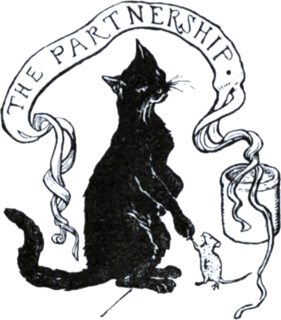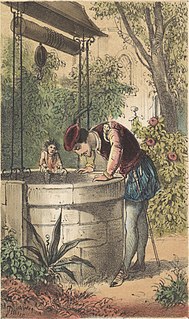Related Research Articles

The Brothers Grimm, Jacob (1785–1863) and Wilhelm (1786–1859), were German academics, philologists, cultural researchers, lexicographers, and authors who together collected and published folklore. They are among the best-known storytellers of folk tales, popularizing stories such as "Cinderella", "The Frog Prince", "Hansel and Gretel", "Little Red Riding Hood", "Rapunzel", "Rumpelstiltskin", "Sleeping Beauty", and "Snow White". Their first collection of folk tales, Children's and Household Tales, began publication in 1812.

"Snow-White and Rose-Red" is a German fairy tale. The best-known version is the one collected by the Brothers Grimm. An older, somewhat shorter version, "The Ungrateful Dwarf", was written by Caroline Stahl (1776–1837). Indeed, that appears to be the oldest variant; no previous oral version is known, although several have been collected since its publication in 1818. Oral versions are very limited regionally. The tale is of Aarne-Thompson type 426.

"The Golden Goose" is a fairy tale collected by the Brothers Grimm. It is a tale of Aarne-Thompson type 571, with an episode of type 513B.

Grimms' Fairy Tales, originally known as the Children's and Household Tales, is a German collection of fairy tales by the Grimm brothers or "Brothers Grimm", Jacob and Wilhelm, first published on 20 December 1812. This first edition contained 86 stories, and by the seventh edition in 1857, it had 210 unique fairy tales.

"Jorinde and Joringel" is a German fairy tale collected by the Brothers Grimm. It is Aarne–Thompson 405. The tale is found virtually exclusively in Germany, barring a Swedish variant, although Marie Campbell found a variant in Kentucky, "The Flower of Dew". The story is known in many English translations as "Jorinda and Jorindel".

"The Juniper Tree" is a German fairy tale published in Low German by the Brothers Grimm in Grimm's Fairy Tales in 1812. The story contains themes of child abuse, murder, cannibalism and biblical symbolism and is one of the Brothers Grimm's darker and more mature fairy tales.
"The Four Skillful Brothers" is a German fairy tale collected by the Brothers Grimm. It is Aarne-Thompson type 653.

"Cat and Mouse in Partnership" is a German fairy tale collected by the Brothers Grimm in Grimms' Fairy Tales. It is a story of Aarne-Thompson type 15.
"The True Bride" or "The True Sweetheart" is a German fairy tale collected by the Brothers Grimm in Grimm's Fairy Tales as tale 186.

"The King of the Golden Mountain" is a German fairy tale collected by the Brothers Grimm in Grimm's Fairy Tales.
"The Turnip" is a German fairy tale collected by the Brothers Grimm in Grimm's Fairy Tales.
A Riddling Tale is a German fairy tale collected by the Brothers Grimm in Grimm's Fairy Tales.

"Mary's Child" is a German fairy tale collected by the Brothers Grimm in Grimm's Fairy Tales in 1812. It is of Aarne-Thompson type 710.
"The Bright Sun Brings It to Light" is a German fairy tale collected by the Brothers Grimm in Grimm's Fairy Tales, tale number 115.

"The Gnome" is a German fairy tale collected by the Brothers Grimm in Grimm's Fairy Tales, tale number 91.
"Looking for a Bride" or "Choosing a Bride" or "Brides on Their Trial" is a German fairy tale collected by the Brothers Grimm in Grimm's Fairy Tales, number 155. It was first added in the second edition.
"Fair Katrinelje and Pif-Paf-Poltrie" is a German fairy tale collected by the Brothers Grimm in Grimm's Fairy Tales as tale 131. A nonsense tale, it was introduced into the first edition as number 45 of the second volume.

The German Fairy Tale Route is a tourist attraction in Germany originally established in 1975. With a length of 600 kilometres (370 mi), the route runs from Hanau in central Germany to Bremen in the north. Tourist attractions along the route are focused around the brothers Wilhelm and Jacob Grimm, including locations where they lived and worked at various stages in their life, as well as regions which are linked to the fairy tales found in the Grimm collection, such as The Town Musicians of Bremen. The Verein Deutsche Märchenstraße society, headquartered in the city of Kassel, is responsible for the route, which travellers can recognize with the help of road signs depicting the heart-shaped body and head of a pretty, princess-like creature.
"The Dog and the Sparrow" is a German fairy tale collected by the Brothers Grimm. It is a story of Aarne-Thompson type 248.

"The Grave Mound" is a German fairy tale collected by the Brothers Grimm, KHM 195. It is Aarne-Thompson type 779, Divine Rewards and Punishments.
References
- ↑ Jacob and Wilheim Grimm, Household Tales, "The Owl"
- ↑ D.L. Ashliman, "The Grimm Brothers' Children's and Household Tales (Grimms' Fairy Tales)"